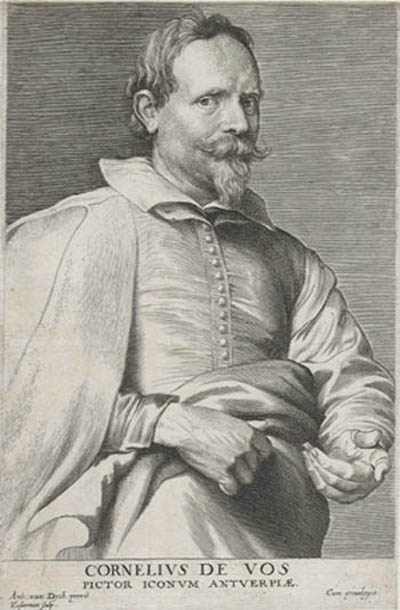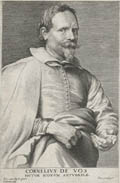| Title: |
Cornelius De Vos, Pictor Iconum Antwerpiae (Cornelis De Vos) |
| Engraver: |
Vorsterman, Lucas (Zaltbommel, 1595 - Antwerp, 1675) |
| Designer: |
Van Dyck (Van Dyke), Anthony (Antwerp, Flanders, 1599 - 1641) |
| Date: |
1645 (First Published Edition by Gillis Hendricx, Antwerp) |
| Medium: |
Original Engraving |
| Note: |
Lucas Vorsterman: One of the most famous
engravers of the School of Rubens, Lucas Vorsterman first studied painting
techniques under that master. Under the advice of Rubens he turned entirely
to the art of engraving and produced many great engravings after his master's
paintings. The two artists thus worked closely together until the early
1620's when, according to most accounts, a serious rift developed between
them. (Several reports, in fact, point to a volatile disagreement resulting
in near fatalities). |
| |
In 1632 Lucas Vorsterman moved to London where he was commissioned by
both King Charles I and the Earl of Arundel. He remained in England for
the following eight years and returned to Antwerp to work in the studio
of Anthony Van Dyck. |
| |
Lucas Vorsterman engraved such famous contemporary portraits as those
of King Charles I, Thomas Howard, Earl of Arundel, William Cavendish and
Isabella Clara Eugenia, Infanta of Spain. He also engraved the likenesses
of such fellow artists as Anthony Van Dyck, Jacques Callot, Theodoor Galle,
Jan Lievens and Cornelis De Vos for the Iconography. |
| |
Cornelis De Vos (Hulst, 1585 - Antwerp, 1651):
Cornelis De Vos was a leading Flemish portrait and historical painter.
A student of Remeeus, he became a master in Antwerp's Guild of St. Luke
in 1608. He later served as Dean of the Guild. Today his paintings are included
in major public museums in Berlin, Antwerp, Brussels, Madrid, Munich and
Vienna. Cornelis De Vos was also a close friend of Anthony Van Dyck. |
| |
Anthony Van Dyck and "The Iconography":
The great age of portrait engraving took place in the early and mid seventeenth
century. In France such remarkable portrait engravers as Robert Nanteuil
and Antoine Masson achieved fame at least equal to the most highly regarded
painters. In Belgium and Holland the division between painter and engraver/etcher
was much less distinct. Rembrandt was as great an etcher as a painter and
both Rubens and Van Dyck conducted a school of engravers under their close
personal supervision. In the 1620's Peter Paul Rubens founded an engraver's
school in Antwerp in order to render his paintings and drawings into copper.
Such great engravers as Lucas Vorsterman (1595-1675), Boetius a Bolswert
(1580-1633) and Paulus Pontius (1603-1658) formed the cornerstone of what
was soon known as the 'School of Rubens'. |
| |
At the age of nineteen Anthony Van Dyck (Antwerp, 1599-1641) was admitted
into the painter's Guild of Antwerp, as a Master. A year later he became
the senior assistant to Rubens. A superb portraitist, Van Dyck became famous
throughout Europe and later was appointed court painter to King James the
First of England. |
| |
Van Dyck was first introduced to both engraving and etching by Peter Paul
Rubens. Around 1630 he began his most ambitious printmaking project to create
a uniform series of engravings of famous contemporaries derived from his
portraits. Van Dyck provided his engravers with extensive preparatory work,
including drawings and oil sketches. He then corrected his engraver's proofs
and even etched the outline features on some of the portraits. In the following
years he designed and supervised about eighty such portrait engravings which
were published individually by Martin van den Enden. His principal engravers
included Paulus Pontius, Nicolaes Lauwers, Pieter de Jode, Lucas Vorsterman,
Robert van Voerst and others. These wonderfully graceful portrait engravings
were a high point of Baroque art and proved to be perhaps the most influential
group of portraits in the history of printmaking. |
| |
The engravings were first published separately by Martin van den Enden,
with his name appearing in the address to the lower right. He did not print
the plates in large editions and thus these earliest of impressions are
very scarce. The Iconography did not appear as a completed set until four
years after Van Dyck's death, in 1645. During this year Gillis Hendricx
published a series of one hundred Van Dyck portrait engravings in three
general categories; I, Princes, II, Scholars, and III, Painters, Engravers,
Sculptors and Patrons of Art. (Interestingly, portrayals of painters and
engravers were placed on a level equal to nobility and scholars. Artists
were deliberately portrayed as men of wealth, knowledge and stature.) Impressions
from this first published set contain the Gillis Hendricx letters, 'G. H.'
along the lower plate mark. |
| |
The demand for portraits from The Iconography was so great that many subsequent
editions were printed in the following decades. The final edition was in
fact published as late as 1759 and many of the plates still survive in the
Louvre. Detecting early from late impressions of portraits from The
Iconography however is not difficult. With the deterioration of lines and contrasts,
late impressions bear only a ghostly relationship to first edition printings.
Secondly, Gillis Hendricx impressions were printed on a fine, laid paper
with a distinct watermark of a Foolscap containing five points, four large
bells and braided hair ( clearly seen in this impression on the verso).
This watermark appears on paper used in both Antwerp and Holland between
1640 and 1660. Lastly, later impressions appear without the 'G. H.' along
the lower plate-mark. This impression of Cornelis De Vos bears the crisp
lines of an early printing and the aforementioned watermark. Yet, as was
common in the seventeenth and eighteenth century, a former owner of the
engraving has cropped the paper to thread margins and eliminated the 'G.
H.' mark. There is no doubt however that this original engraving is from
the Gillis Hendricx edition of 1645. |
| Raisonne: |
F. Wibiral, L'Iconographie d' Antonie Van Dyck, Leipzig, 1877. |
| |
Third and final state, as published in the 1645 Hendricx edition. |
| Source: |
Icones Principum Virorum Doctorum Chalcographorum Statuariorum Nec Non
Amatorum Pictoriae Attis Numero Centum Ab Antonio van Dyck Pictore Ad Vivum
Expressae Eivsque Sumptibus Aeri Incisae (The Iconography) |
| Size: |
9 3/4 X 6 1/4 (Sizes in inches are approximate, height preceding width of plate-mark or image.) |
| |
Matted With 100% Archival Materials |
| Condition: |
Printed upon fine 17th century, hand-made, laid paper as published in
Antwerp in 1645 by Gillis Hendricx. Containing the period foolscap watermark,
as described. Cropped to the image by a previous owner, else a fine, early
impression and in good condition throughout. Cornelis De Vos represents
a strong, original example of portrait engraving of Lucas Vorsterman and
of the famous Iconography of Anthony Van Dyck. |
| Subject: |
Lucas Vorsterman, Anthony van Dyck, "Cornelius De Vos, Pictor Iconum Antwerpiae (Cornelis De Vos)", original engraving, Antwerp's Guild of St. Luke, Gillis Hendricx, 17th century Dutch portrait art. |
| Price: |
Sold - The price is no longer available. |
| Important Information: |
The artist biographies, research and or information pertaining to all the original works of art posted on our pages has been written and designed by Greg & Connie Peters exclusively for our site, (www.artoftheprint.com). Please visit us regularly to view the latest artworks offered for sale. We will soon be posting an update of our most recent research and include the biographical and historical information pertaining to our next collection of original works of art created by artists throughout the centuries. We hope you found the information you were looking for and that it has been beneficial.
Our Gallery, (Art of the Print / www.artoftheprint.com) guarantees the authenticity of every work of art we sell 100%. Full documentation and certification is provided. We offer a wide selection of international fine art dating from the early Renaissance to the contemporary art period. |


















![]()
![]() or
phone Greg & Connie (905) 957-6666
or
phone Greg & Connie (905) 957-6666